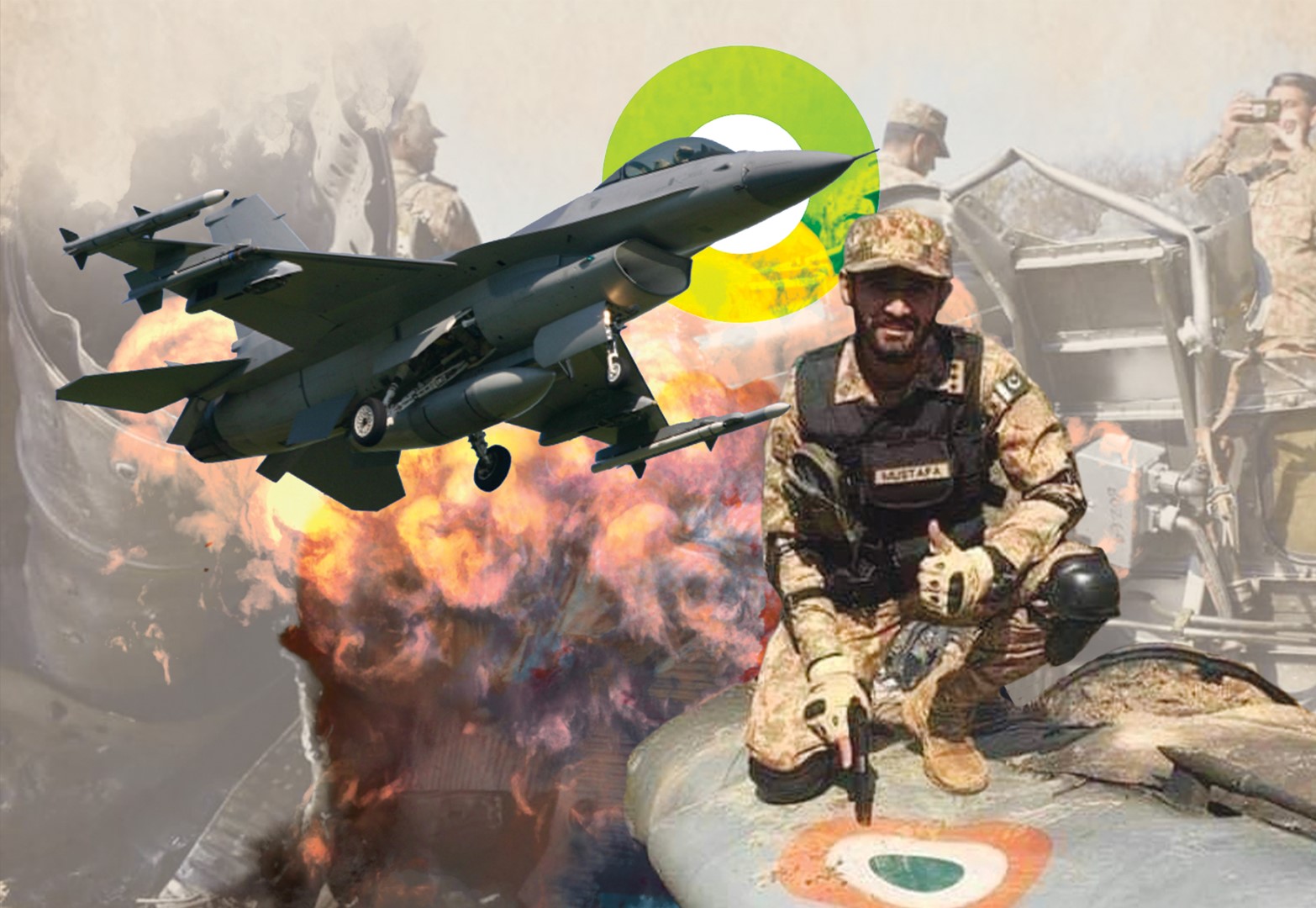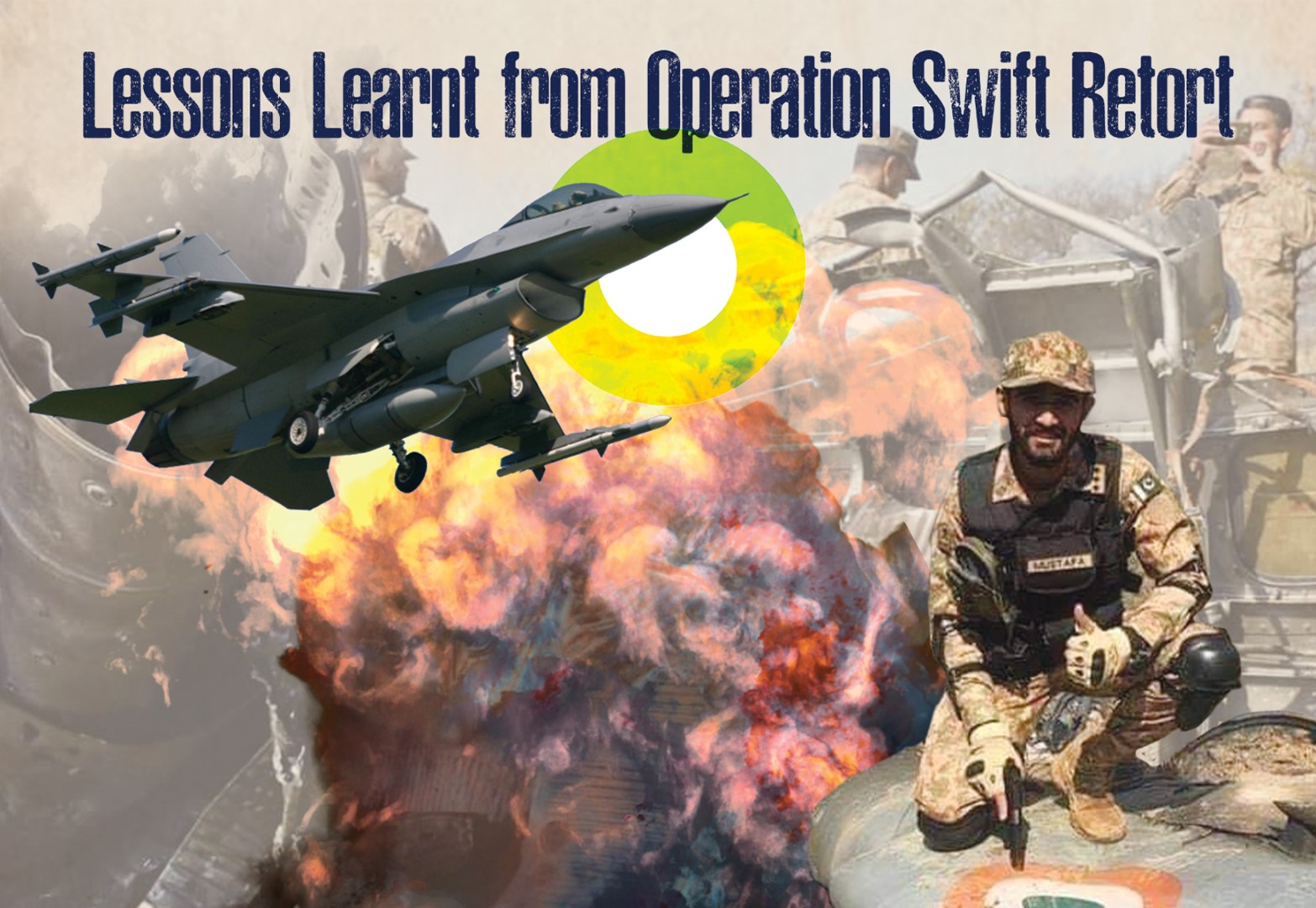Signalian
PDF THINK TANK: CONSULTANT

- Joined
- Aug 18, 2015
- Messages
- 10,608
- Reaction score
- 305
- Country
- Location
Lessons Learnt from Operation Swift Retort
Since 2019, every year February serves as reminder of the Balakot strike as well as Pakistan’s befitting response to India

The Balakot strike by the Indian Air Force (IAF) on February 26, 2019, and Pakistan Air Force’s (PAF) ‘Swift Retort’ a day later can be considered watershed events in modern aerial warfare. Though the IAF’s strike was beset with technical snags, including failure of stand-off bombs to guide themselves to the target due to faulty terrain elevation data, it was able to deliver the ordnance – albeit, in the pine forests – from as far as 40 kms away. Interception of the ingressing IAF fighters threw up a new conundrum: flying in their own territory, the hostile intentions of the fighters could not be read in advance and they could not be fired at lest Pakistan be accused of unprovoked aggression. After weapons release, the IAF aircraft rapidly turned back and could not be chased for the fear of violating the international rules of engagement as the release of bombs – and breach of peace – was discovered only after some time.
The key to any Pakistani response to Indian aggression was prompt decision-making by the government. The Prime Minister immediately went into parleys with the service chiefs, and a proportionate response by PAF was agreed upon. With a decision taken by the Prime Minister to definitely respond, the nuts and bolts of the operation were left to the Chief of the Air Staff. The latter was mindful of the possibility of escalation and the planning process that followed duly took this aspect into account.
The key to any Pakistani response to Indian aggression was prompt decision-making by the government. The Prime Minister immediately went into parleys with the service chiefs, and a proportionate response by PAF was agreed upon.
PAF retaliated within 30 hours of the IAF’s strike, and hit Indian targets with stand-off bombs, staying well within our own territory. The sizeable strike package including its escorts, as well as the accompanying fighter sweep aircraft, swamped the Indian air defence radar scopes and the patrolling Su-30 aircraft were promptly vectored towards the PAF swarm. Sooner the PAF strike fighters had delivered the bombs and turned around, the F-16s and JF-17s swept the skies with very useful support from the data-linked airborne early warning and control (AEW&C) and ground radars, as well as from own formation members. The pilots were glued to their multi-function displays streaming vital information and firing cues. It was as if a whole squadron was playing a mass video game in the skies. With excellent situational awareness, and the adversary in disarray, an approaching Su-30 was targeted by one of the PAF fighters with a Beyond Visual Range missile. Besides the Su-30s, the patrolling IAF Mirage 2000s seemed shell-shocked as well and did not enter the fray. MiG-21 Bisons on ground alert had, therefore, to be scrambled. All this time PAF’s airborne and ground jammers were at work, and the IAF pilots and air defence controllers were thrown into total confusion. As one of the scrambled MiGs appeared on the radar scope of another PAF fighter aircraft, a missile was fired, which shot the MiG out of the sky, the pilot surviving by a whisker and parachuting into Pakistani territory.
The mission flown by PAF was unique in many ways. The ground targets had been identified and prepared well in advance for exactly such an eventuality. The pilots had routinely practised flying in formations as large as 50 aircraft, with electronic countermeasure (ECM) support and comprehensive situational awareness provided by the AEW&C aircraft. BVR missiles were used in the Indo-Pak scenario for the first time; interestingly, close combat situations did not crop up for the classic dogfighters. It was manifest that BVR combat had taken precedence over close combat, if not rendering it completely obsolete.
A fighter in any future conflict must therefore have both long and short range missile firing capabilities along with associated sensors like radars, threat warning systems, and data links. PAF could do well by urgently replacing its legacy fighters with ‘home-grown’ JF-17s (especially the upcoming Block III version) which have all the desirable attributes at an affordable cost.
For surface attack, stand-off capabilities were demonstrated by both air forces, and the safety of attacking an aircraft was clearly highlighted. Accuracy of the attacks was, however, not achieved for different reasons: the IAF suffering from faulty terrain data being fed into the bombs’ guidance system, and PAF being constrained by political considerations to prevent escalation by avoiding direct hits on military targets. In any case, the efficacy of stand-off weapon delivery was unmistakably validated, and it is certain that this is likely to be the mode of choice in any future conflict. An aircraft not having such a weapon delivery capability should be considered redundant for surface attack missions.
All this time PAF’s airborne and ground jammers were at work, and the IAF pilots and air defence controllers were thrown into total confusion. As one of the scrambled MiGs appeared on the radar scope of another PAF fighter aircraft, a missile was fired, which shot the MiG out of the sky, the pilot surviving by a whisker and parachuting into Pakistani territory.
India had the initiative, and could also exploit the element of secrecy and surprise to its advantage. However, these possible benefits were squandered by the IAF as the operation was flawed in its planning and entirely disastrous in its execution. Some of the basic planning considerations were flouted: cloudy weather resulted in the cancellation of the electro-optical weapons delivery; elevation data fed into the autonomous Spice 2000 bombs was in error; capabilities of the PAF’s BVR air-to-air missiles were not well-known to the IAF aircrew; and the determination as well as the state of readiness of PAF was taken lightly. More serious was the failure of IAF’s patrolling fighters to pick up the gauntlet when challenged, allowing PAF fighters to have a free run; it reflected poorly on the morale and training of IAF pilots. Oversight of the operation was faulty at all levels of command and cannot be put down to bad luck by an air force that claims to be professional.
Despite PAF finding itself in a reactive mode, the latter’s full operational preparedness clearly saved the day. The whole operation was over within 48 hours, and the deployment of strike elements of ground forces did not take place. It became amply clear that air forces offer the best and swiftest means of retribution under a nuclear overhang as the relatively slow positioning of ground troops to their operational areas is fraught with the possibility of being stymied due to international pressure. PAF’s tour de force will, thus, serve as a model for dealing with any future Indian military action that is punitive in nature. PAF’s preparedness must continue to be refined as IAF is expected to iron out the hitches that dogged its operations during the failed Balakot strike.
It is to be noted that after a disastrous showing by IAF on February 26 and 27, the Indian government unwisely decided to even the score by deploying – conceivably, for employing – surface-to-surface missiles (SSMs) against targets in Pakistan. Apparently, this measure was aimed at preventing further fighter losses at the hands of the PAF that was perceived by the IAF as being technically superior. Exercise of the rash and senseless decision to deploy SSMs could well have been misconstrued by Pakistan and a catastrophic exchange could have followed between the two nuclear-armed neighbours. The Government of Pakistan, as well as its Armed Forces, should treat it as a textbook lesson in regional conflict escalation dynamics and must remain cognisant of such developments in any future conflict.
More serious was the failure of IAF’s patrolling fighters to pick up the gauntlet when challenged, allowing PAF fighters to have a free run; it reflected poorly on the morale and training of IAF pilots. Oversight of the operation was faulty at all levels of command and cannot be put down to bad luck by an air force that claims to be professional.
With the Rubicon having been crossed after the Balakot raid, use of IAF fighters to compliment the usual artillery shelling across the Line of Control is likely to be the new norm for intimidating Pakistan.
Though the failed IAF strike did not bring any concrete dividends, it did open up the possibility for India to repeat such actions in the future. The mistakes made in planning and execution of February 26/27, 2019 operation are certain to have been remedied, and it would be naïve to believe that India is not raring for a revenge bout. India has never digested the fact that its military options against Pakistan have been thwarted by the latter’s nuclear capability. To keep an upper hand as a regional player, India is likely to resort to periodic muscle-flexing through so-called ‘surgical strikes.’ Pakistan’s military, especially the quick-reacting PAF, needs to maintain its operational readiness at the cutting edge to deter India from any adventurism in the future.
Unfortunately, the reaction of the international community to India’s brazen aggression against Pakistan was muted and any outright condemnation was absent. The closest any country got to a disapproval was a ‘neither here nor there’ statement, calling all parties to exercise restraint. In an environment where freedom movements are labelled as terror campaigns – as in Indian Illegally Occupied Jammu and Kashmir and Palestine – it is not difficult for host governments to justify punitive actions against suspected supporters. Pakistan needs to be wary of this reprehensible trend, and needs to be at the diplomatic forefront to quell hostile propaganda by its adversaries, especially India.

Lessons Learnt from Operation Swift Retort
Since 2019, every year February serves as reminder of the Balakot strike as well as Pakistan’s befitting response to India The Balakot strike by the Indian Air Force (IAF) on February 26, 2019, and Pakistan Air Force’s (PAF) ‘Swift Retort’ a day later can be considered watershed events in...
The writer is a retired fighter pilot and aviation historian.
E-mail: ksrtfl@gmail.com







